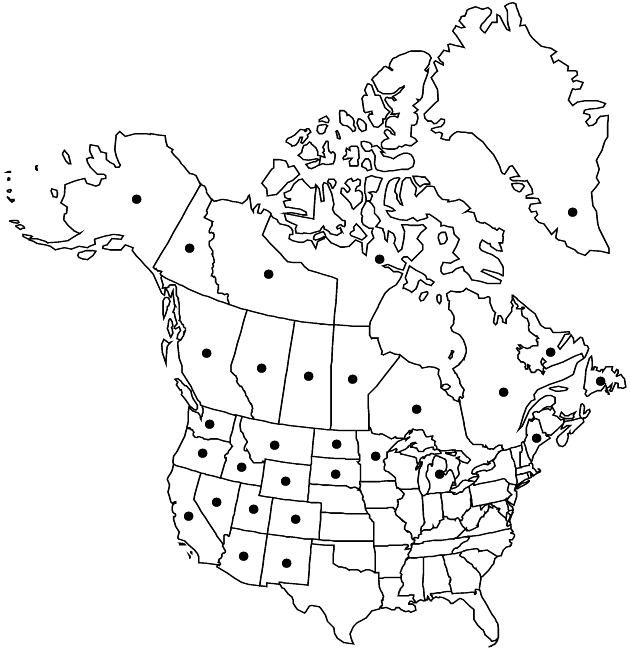Antennaria rosea
Pittonia 3: 281. 1898.
Gynoecious (staminate plants uncommon). Plants 4–30 cm. Stolons 1–7 cm. Basal leaves 1-nerved, 8–40 × 2–10 mm, spatulate, oblanceolate, or cuneate, tips mucronate, faces usually gray-pubescent, adaxial sometimes green-glabrous. Cauline leaves linear, 6–36 mm, usually not flagged (apices acute to subulate or with lanceolate flags). Heads 3–20 in corymbiform arrays. Involucres: staminate unknown; pistillate 4–10 mm. Phyllaries distally brown, cream, gray, green, pink, red, white, or yellow (apices acute or erose-obtuse). Corollas: staminate unknown; pistillate 2.5–6 mm. Cypselae 0.7–1.8 mm, glabrous or papillate; pappi: staminate unknown; pistillate 3.5–6.5 mm. 2n = 42, 56, (70).
Distribution

Alta., B.C., Man., N.W.T., Nfld. and Labr., Nunavut, Ont., Que., Sask., Yukon, Alaska, Ariz., Calif., Colo., Idaho, Maine, Mich., Minn., Mont., N.Dak., N.Mex., Nev., Oreg., S.Dak., Utah, Wash., Wyo.
Discussion
Subspecies 4 (4 in the flora).
Antennaria rosea is the most widespread Antennaria of North America, occurring in dry to moist habitats from near sea level to the alpine zone. The A. rosea polyploid agamic complex is one of the more morphologically diverse complexes of North American Antennaria. It occurs from the western cordillera of North America from southern California, Arizona, and New Mexico north to subarctic Alaska and east to Greenland and, disjunctly, in the Canadian maritime provinces, eastern Quebec, and immediately north of and adjacent to Lake Superior (R. J. Bayer et al. 1991). Antennaria chilensis (including A. chilensis var. magellanica) is a Patagonian endemic that morphologically fits within the circumscription of A. rosea and may well be an amphitropical disjunct member of the complex.
Antennaria rosea is taxonomically confusing; it includes agamospermous microspecies that have been recognized as distinct taxonomic species. Morphometric and isozyme analyses have demonstrated that the primary source of morphologic variability in the complex derives from six sexually reproducing progenitors, A. aromatica, A. corymbosa, A. pulchella, A. microphylla, A. racemosa, and A. umbrinella (R. J. Bayer 1989b, 1990b, 1990c). Additionally, three other sexually reproducing species, A. marginata, A. suffrutescens, and A. rosulata, may have contributed to the genetic complexity of the A. rosea complex (Bayer 1990b). Here, four reasonably distinct subspecies are recognized within the complex.
Selected References
None.
Lower Taxa
Key
| 1 | Basal leaves 20–40 mm; phyllaries distally usually green, pink, red or white, seldom brown | Antennaria rosea subsp. rosea |
| 1 | Basal leaves 8–20 mm; phyllaries distally brown, cream, gray, green, pink, red, white, or yellow | > 2 |
| 2 | Pistillate: involucres 4–6.5 mm, corollas 2.5–4, pappi 3.5–5; cauline leaves 6–20 mm (tips subulate); phyllaries usually distally brown, sometimes cream, gray, or yellow | Antennaria rosea subsp. confinis |
| 2 | Pistillate: involucres 6.5–10 mm, corollas 3.5–6 mm, pappi 5–6.5 mm; cauline leaves 6–19 or 9–26 mm (tips sometimes with flat, lanceolate scarious appendages); phyllaries distally brown, green, pink, red, or white | > 3 |
| 3 | Plants 19–30 cm; cauline leaves 9–26 mm (proximalmost usually 19+ mm); heads usu- ally 6–12 | Antennaria rosea subsp. arida |
| 3 | Plants 4–17 cm; cauline leaves 6–19 mm (proximalmost usually less than 19 mm); heads usually 3–5 | Antennaria rosea subsp. pulvinata |